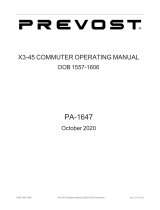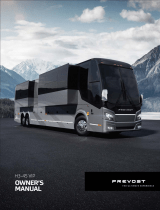
i
TABLE OF CONTENTS
FOREWORD........................................................iii
SAFETY PRECAUTIONS ...................................iv
COACH EXTERIOR .........................................1-1
Engine compartment rear door.........................1-3
Engine compartment R.H. side door ................1-3
Main power compartment .................................1-4
Wheelchair lift door............................................1-4
Baggage compartments....................................1-4
Fuel filler door.................................................... 1-4
A/C condenser door..........................................1-4
Entrance door....................................................1-5
Rear-view mirrors..............................................1-5
Reclining bumper compartment........................1-7
HVAC compartment..........................................1-7
Rear electric compartment................................1-7
Engine radiator door.......................................... 1-8
Retractable back-up camera.............................1-8
110-120 volt in-station connector......................1-8
COACH INTERIOR........................................... 2-1
DRIVER'S AREA...............................................2-1
Entrance door....................................................2-1
Destination signs............................................... 2-1
Driver's personal compartment.........................2-1
Ashtray...............................................................2-1
Cigarette lighter.................................................2-2
Adjustable HVAC registers ...............................2-2
Driver's power window ...................................... 2-2
Sun visors (blinds).............................................2-2
Inside mirrors.....................................................2-2
Safety Belt .........................................................2-2
Driver's seat.......................................................2-3
Tour guide seat..................................................2-5
Microphone jacks ..............................................2-5
PASSENGERS' AREA......................................2-6
Passenger seats................................................2-6
Swivel seats.......................................................2-6
Exits...................................................................2-6
Ventilation hatch................................................2-6
Adjustable air registers......................................2-7
Stop/service chime............................................2-7
Reading lamp ....................................................2-7
Sun visor (blind).................................................2-7
Folding trays......................................................2-8
Waste container ................................................2-8
Card tables ........................................................2-8
Quick-lounge .....................................................2-8
Galley................................................................. 2-9
Lavatory.............................................................2-9
CONTROLS & INSTRUMENTS.......................3-1
KEYS..................................................................3-1
DRIVER'S AREA ...............................................3-2
L.H. CONTROL PANEL.....................................3-3
Transmission display.........................................3-3
Cruise control.....................................................3-3
Driver's power window switch............................3-4
Mirror controls....................................................3-4
Tag axle control valve........................................3-4
Parking brakes control valve .............................3-5
Water heater timer.............................................3-5
Low buoy control valve......................................3-5
Parking brakes override valve...........................3-5
Diagnostic data reader (DDR) receptacle.........3-5
Steering wheel adjustment unlock air valve......3-6
Dashboard compartments.................................3-6
Rear-view TV monitor........................................3-6
Cigarette lighter..................................................3-6
Ashtray...............................................................3-6
Utility compartment............................................3-6
DASHBOARD....................................................3-7
Control switches.................................................3-8
Trip data recorder (TDR).................................3-12
Telltale panel....................................................3-12
Gauges.............................................................3-16
Vehicle height...................................................3-17
Front door buttons............................................3-17
Control head.....................................................3-17
Radio................................................................3-18
HVAC control unit ............................................3-18
Brightness control............................................3-19
Ignition switch...................................................3-19
Air registers......................................................3-19
STEERING COLUMN CONTROLS................3-26
Transmission output retarder ..........................3-20
Multifunction lever............................................3-20
Horns................................................................3-21
FOOT-OPERATED CONTROLS....................3-21
Service brakes .................................................3-21
Acceleratior pedal............................................3-22
Steering wheel adjustment unlock air valve....3-22
MANUAL TRANSMISSION.............................3-29
SEMI-AUTOMATIC TRANSMISSION............3-23
AUTOMATIC TRANSMISSION.......................3-23
OTHER FEATURES..........................................4-1
Detroit Diesel Electronic Control System .........4-1
Detroit Diesel Data Hub.....................................4-2
Trip Record Access (TRAC)..............................4-2
DDEC IV electronic control module (ECM).......4-4
Water heater ......................................................4-5



































